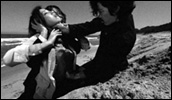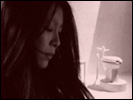Mandala
- Year
- 1971
- Original title
- Mandara
- Japanese title
- 曼荼羅
- Director
- Cast
- Running time
- 136 minutes
- Published
- 22 September 2008



by Rea Amit
In recent years we have seen a growing (cinematic) interest in Japan with cults, pseudo religions, and with the trauma that these groups might leave on their own members and on their surroundings. As the media in Japan keep on briefing us about the trial of Aum Shinrikyo's infamous leader Shoko Asahara, films such as Akihiko Shiota's Canary (Kanaria, 2005) and the excellent documentary A (1998) by Tatsuya Mori, which was then followed by A2 (2001), might have been thought of as a primal glance into the all too human world of religious fanaticism.
Yet in fact, cult mania is not entirely something new to Japanese cinema. Akio Jissoji's Mandala portrays a story of the same kind, namely that of an evil cult. Mandala is the middle part of Jissoji's Buddhist trilogy which opened with This Transient Life (Mujo, 1970) and sealed with Poem (Uta, 1972). While each part shows a strong thematic commitment with several Buddhist ideas, each one is also cinematically and narratively unique in itself.
A few words should be dedicated to introducing the director Akio Jissoji, as this film has played an important part in his cinematic career. Mostly known as a director of films, television dramas, and even commercials, he was also a writer, a calligraphy artist, theatre, television, and opera stage director, and a professor in the music department at Tokyo National University of Fine Arts and Music. Moreover, Jissoji was also known for his bizarre overwhelming infatuation with trains of all kinds and said to have a huge collection of train models. Indeed, as the name of the series he first worked on implies, Jissoji was a real Ultraman, in both the positive and the somewhat estranged sense of the word.
As a film director Jissoji was a member of Nagisa Oshima's close circle and was inspired by and an inspiration to the Japanese Nouvelle Vague movement. However, while the main ideology around the rest of the members was either Marxist or politically oriented, Jissoji thought higher. Where the radical young film directors dreamed of a better or reformed society, Jissoji thought of a reformed man. This overcoming man is not just a Nietzschean Übermensch idea; a man who overcomes all moral conventions was just a step for Jissoji (well taken in This Transient Life), whose reformed man is a man of a true religion, namely Buddhism in its more profound Japanese form, known as Zen, a notion that is much more far-reaching and goes by far more radical applications.
Mandala portrays common aspects with Zen thought, first and most profoundly by its means of depiction, mainly by the somewhat blurred logic upon which the composition of this film rests. Zen speaks of contradiction's unity, of a world in which good and evil lie together without any contradiction. In Mandala the style seems to be torn between that of the pinku, bi kurasu (B-class) "loose" style of filming and that of the experimental but also meticulous Nouvelle Vague style, between highly sophisticated camera movement and frame building, and on the other side the sometimes very simple, naïve, even simplistic dialogue and characteristic establishing. It also seems to be contrasting at the same time, both "traditional" Japanese aesthetics, for example that of Japanese gardening (especially that of the Zen style gardening known as Karesansui) and of late modern and Western architecture, as well as natural and urban landscapes. We can see in this film a beautifully constructed scene, as the late Teshigahara might have composed (for example in Rikyu, 1998) of people wearing kimono and geta clogs which is followed by a scene set in an ultra modern environment, shot in a stylish and even provocative manner; kind of a duplex with a matching editing and camera that emphasises these contradictions.
The story itself is no different from the general mood by which it is represented. While the dialogue sometimes tends to challenge the patience of even the most tolerant viewer, other scenes, strikingly those cheesy sex ones, tend to throw the viewer to the opposite side. An example of this is presented right from the beginning. Located in a sophisticatedly formed room, a modern-day Don Juan is stylishly depicted satisfying his female partner. Yet the scene is then followed by one depicting the same guy with another girl on the beach where they are soon attacked by two vicious thugs who brutally rape the woman. Not yet well attuned with the film's rhythm, we then witness the man regaining his consciousness, approaching the woman and tenderly kissing her, after which he and his cheerful partner enter the sea for a romantic, almost grotesque erotic shot amid the waves.
The rapists, we will learn to know, are just "doing their job" within the cult, raping for the sake of raping - one of the cult's "secreted" rituals. Many more of these kinds of undertakings follow, but the bizarreness of its introduction puzzles the viewer, who will find it hard to determine the occurrences in front of his eyes. This is without any doubt a deliberate act, meant to confuse and to depart the viewer from his normal way of viewing and logical analysing. And maybe it was also meant even to place the viewer in a completely different mental state, where good and evil, ugliness and beauty mysteriously coexist.
The cult seems at first something else, an entirely original religious exposé where the incarnation of god is a woman. However, there is a male figure who we gradually realize is the true leader of the group. He orders the rapists to bring along more "sex freed" women, sometimes first seduced by the newly recruited Don Juan and sometimes even already existing members of the group. The leader controls the group's actions with rhetorical, pseudo-intellectual lectures, with which he also persuades the members into their mischief activity. Yet, as the movie evolves, the Don Juan-like figure starts to realize what is really going on and he finally rebels after the leader orders one of the female members to her death. He then turns to bring out the truth about the group's ideology, using a tactic that might seem rather strange: by trying to rape the woman who until then was acknowledged as god's vehicle on earth.
What is the meaning of all this? The first thing we must recognize from a true Zen perspective is that there are no metaphors, what we see is what there is. God is not a seen phenomena or entity that should be advocated by saints or political leaders, it is a spiritual task for individuals only to undertake. Moreover, while Zen and Buddhism in general promote the midway between the ethics of good and evil, they don't reject the notion of wrongdoing; harming others, whether humans, animals, or even the natural environment, is strictly forbidden.
Jissoji claims in one of his books on Ultraman (Uruturaman no Dekiru made) that he was strongly influenced by the great French pioneer filmmaker Georges Méliès. While this may be a fact very well felt in his Ultraman series, it is hard to even guess it in Mandala, which seems to be constructed worlds apart from fantastical sci-fi. Be that as it may, the feelings brought into play in both cases are remarkably similar, they are of wonder, of question and doubt. What Jissoji might want us to see is the nature of things as they are and he asks us to rely on nobody but ourselves in both interpreting and making sense of it. Life, after all is something that happens only once and no matter how much you may study it you will never reach the secrets of its creation. It is like a Tibetan Mandala on which monks work day and night only to destroy it after it is completed - for the mere reason that nothing is eternal and everything must eventually come to an end. This is the contradiction that might eventually make an aesthetical beauty possible.